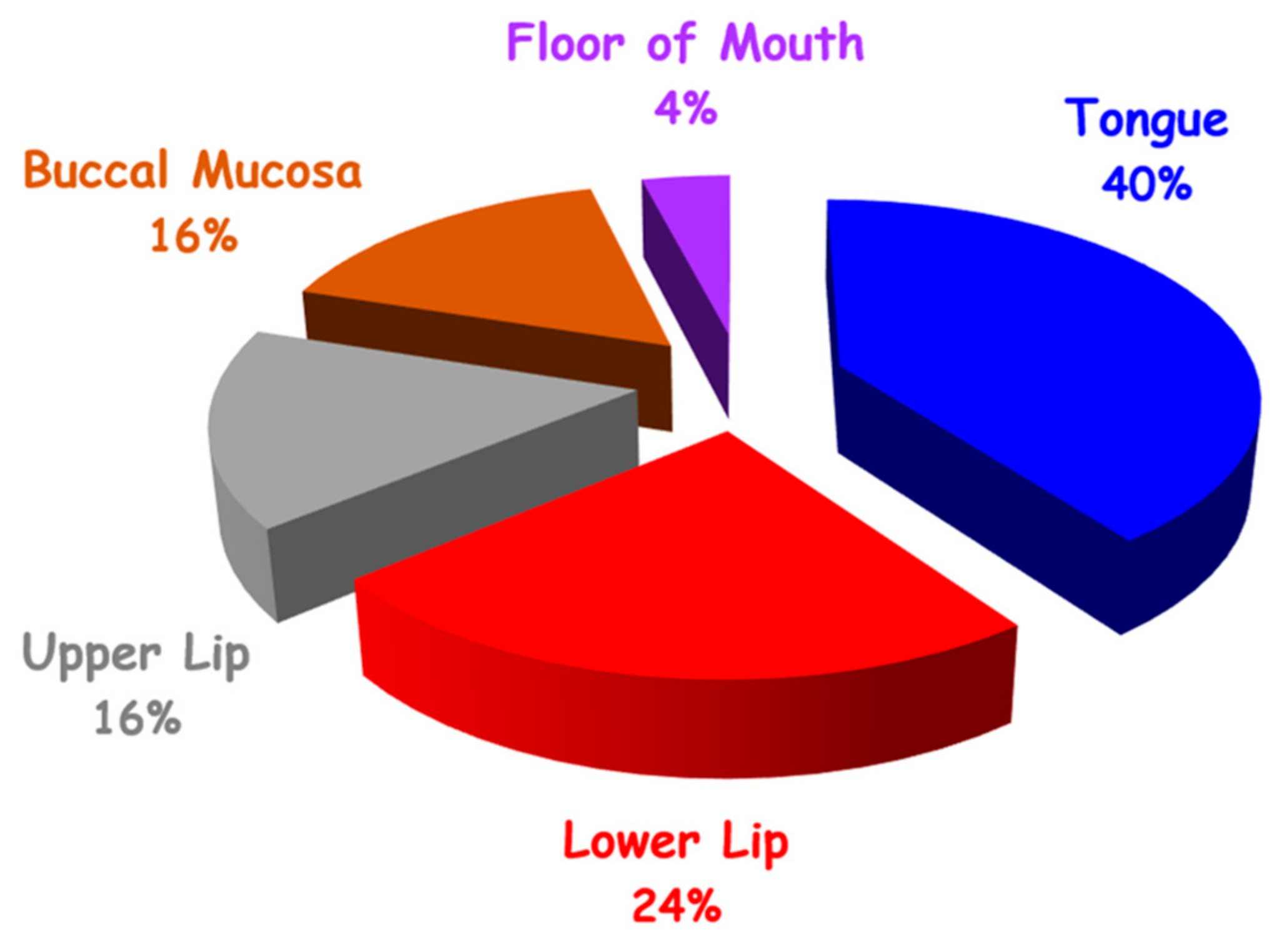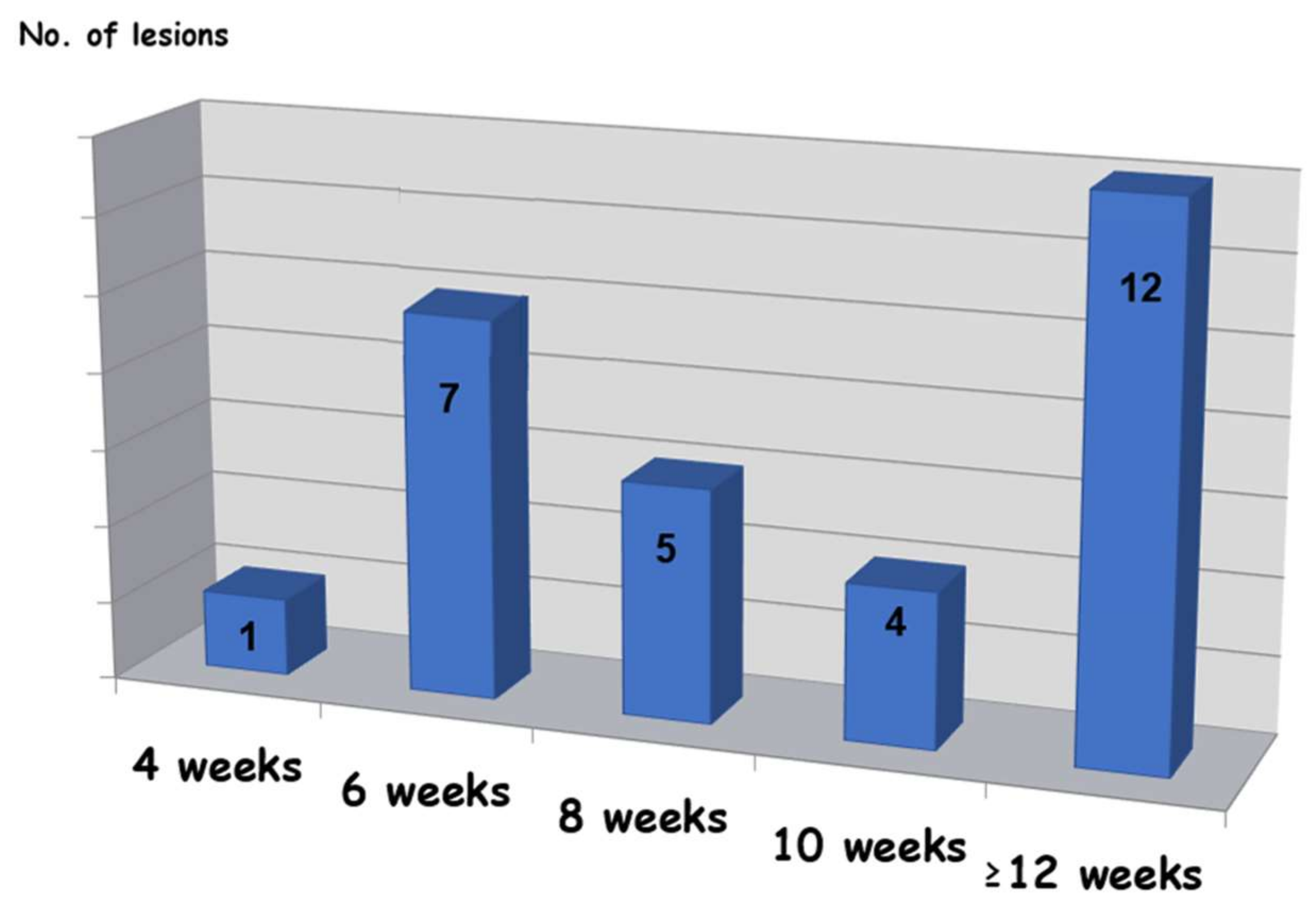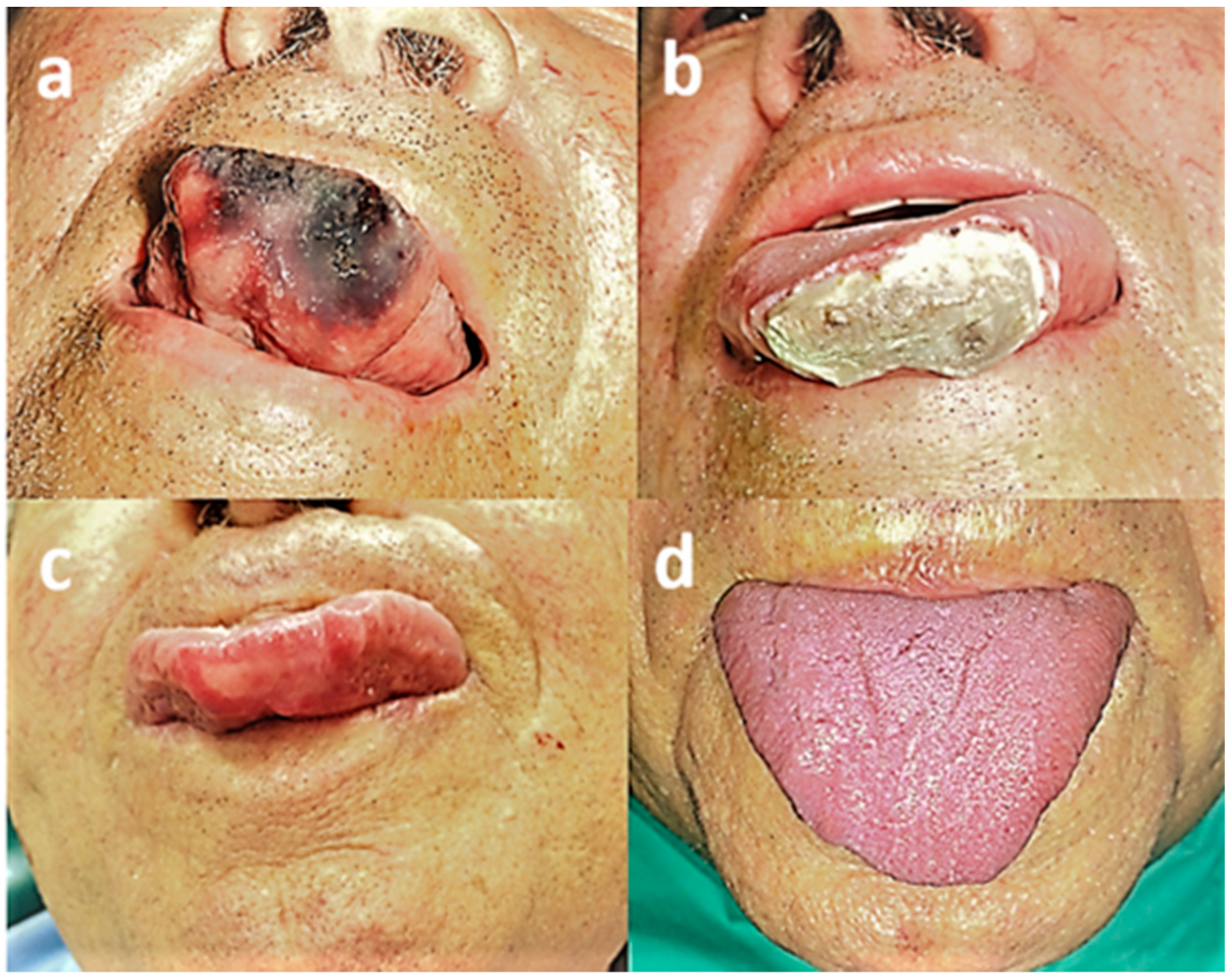Sclerotherapy of Vascular Malformations in the Oral Cavity—Minimizing Postoperative Morbidity
Abstract
1. Introduction
2. Materials and Methods
2.1. Characterization and Data Collection
2.2. Inclusion Criteria
- Clinical observation of painless purplish vesicles or bullae with soft consistency on palpation.
- Diascopy showing changes in coloring, intralesional ischemia, and decrease or alteration in e shape.
2.3. Exclusion Criteria
- High-flow VMs,
- inadequate available data, and
- Patient’s medication interfering with wound healing (e.g., steroids, bisphosphonates, anticoagulants) or specific states preventing the use of EAO (e.g., pregnancy, lactation).
2.4. Sclerotherapy
2.5. Morbidity Score
2.6. Statistical Analysis
3. Results
4. Discussion
5. Conclusions
Author Contributions
Funding
Conflicts of Interest
References
- Markovic, J.N.; Nag, U.; Shortell, C.K. Safety and efficacy of foam sclerotherapy for treatment of low-flow vascular malformations in children. J. Vasc. Surg. Venous Lymphat. Disord. 2020. [Google Scholar] [CrossRef]
- Zúñiga-Castillo, M.; Teng, C.L.; Teng, J.M.C. Genetics of vascular malformation and therapeutic implications. Curr. Opin. Pediatr. 2019, 31, 498–508. [Google Scholar] [CrossRef] [PubMed]
- Wójcicki, P.; Wójcicka, K. Epidemiology, diagnostics and treat-ment of vascular tumours and malformations. Adv. Clin. Exp. Med. 2014, 23, 475–484. [Google Scholar] [CrossRef] [PubMed]
- Clemens, R.K.; Pfammatter, T.; Meier, T.O.; Alomari, A.I.; Amann-Vesti, B.R. Vascular malformations revisited. Vasa 2015, 44, 5–22. [Google Scholar] [CrossRef] [PubMed][Green Version]
- De Maria, L.; De Sanctis, P.; Balakrishnan, K.; Tollefson, M.; Brinjikji, W. Sclerotherapy for venous malformations of head and neck: Systematic review and meta-analysis. Neurointervention 2020, 15, 4–17. [Google Scholar] [CrossRef] [PubMed]
- Couto, D.A.F.; Ito, F.A.; Lima, H.G.; Novais, J.D.; Novais, J.B.; Dallazen, E.; Takahama, A., Jr. Sclerotherapy for Extensive Vascular Malformation in the Tongue. J. Craniofac. Surg. 2019, 30, e796–e799. [Google Scholar] [CrossRef] [PubMed]
- Buckmiller, L.M. Update on hemangiomas and vascular malformations. Curr. Opin. Otolaryngol. Head Neck Surg. 2004, 12, 476–487. [Google Scholar] [CrossRef]
- Hoque, S.; Das, B.K. Treatment of venous malformations with ethanolamine oleate: A descriptive study of 83 cases. Pediatr. Surg. Int. 2011, 27, 527–531. [Google Scholar] [CrossRef]
- Dubois, J.; Soulez, G.; Oliva, V.L.; Berthiaume, M.J.; Lapierre, C.; Therasse, E. Soft-tissue venous malformations in adult patients: Imaging and therapeutic issues. Radiographics 2001, 21, 1519–1531. [Google Scholar] [CrossRef]
- García, E.D.; Jiménez, I.F.; Carrera, M.T.; González, F.S. Hemangiomas y malformaciones vasculares. ¿Qué se puede hacer? Bol. Pediatr. 2001, 41, 137–143. [Google Scholar]
- Zheng, J.W.; Mai, H.M.; Zhang, L.; Wang, Y.A.; Fan, X.D.; Su, L.X.; Qin, Z.P.; Yang, Y.W.; Jiang, Y.H.; Zhao, Y.F.; et al. Guidelines for the treatment of head and neck venous malformations. Int. J. Clin. Exp. Med. 2013, 6, 377–389. [Google Scholar]
- Ogawa, Y.; Inoue, K. Electrothrombosis as a treatment of cirsoid angioma in the face and scalp and varicosis of the leg. Plast. Reconstr. Surg. 1982, 70, 310–318. [Google Scholar] [CrossRef] [PubMed]
- Isola, G.; Alibrandi, A.; Rapisarda, E.; Matarese, G.; Williams, R.C.; Leonardi, R. Association of vitamin D in patients with periodontitis: A cross-sectional study. J. Periodontal Res. 2020. [Google Scholar] [CrossRef] [PubMed]
- Isola, G.; Alibrandi, A.; Currò, M.; Matarese, M.; Ricca, S.; Matarese, G.; Ientile, R.; Kocher, T. Evaluation of salivary and serum ADMA levels in patients with periodontal and cardiovascular disease as subclinical marker of cardiovascular risk. J. Periodontol. 2020. [Google Scholar] [CrossRef] [PubMed]
- Gibson, C.C.; Zhu, W.; Davis, C.T.; Bowman-Kirigin, J.A.; Chan, A.C.; Ling, J.; Walker, A.E.; Goitre, L.; Delle Monache, S.; Retta, S.F.; et al. Strategy for identifying repurposed drugs for the treatment of cerebral cavernous malformation. Circulation 2015, 131, 289–299. [Google Scholar] [CrossRef]
- Horbach, S.E.; Lokhorst, M.M.; Saeed, P.; de Goüyon Matignon de Pon-touraude, C.M.; Rothová, A.; van der Horst, C.M. Sclerotherapy for low-flow vascular malformations of the head and neck: A systematic review of sclerosing agents. J. Plast. Reconstr. Aesthet. Surg. 2016, 69, 295–304. [Google Scholar] [CrossRef]
- Ribeiro, M.C.; Grossmann, S.D.M.C.; do Amaral, M.B.F.; de Castro, W.H.; Navarro, T.P.; Procopio, R.J.; da Silva, T.A.; de Oliveira, C.d.N.A.; Mesquita, R.A. Effectiveness and safety of foam sclerotherapy with 5% ethanolamine oleate in the treatment of low-flow venous malformations in the head and neck region: A case series. Int. J. Oral Maxillofac. Surg. 2018, 47, 900–907. [Google Scholar] [CrossRef]
- Hyodoh, H.; Hori, M.; Akiba, H.; Tamakawa, M.; Hyodoh, K.; Hareyama, M. Peripheral vascular malformations: Imaging, treatment approaches, and therapeutic issues. Radiographics 2005, 25 (Suppl. 1), S159–S171. [Google Scholar] [CrossRef]
- Manzano, B.R.; Premoli, A.M.; Santaella, N.G.; Ikuta, C.R.; Rubira, C.M.; da Silva Santos, P.S. Sclerotherapy as an esthetic indication in oral vascular malformations: A case series. An. Bras. Dermatol. 2019, 94, 521–526. [Google Scholar] [CrossRef]
- Choi, Y.H.; Han, M.H.; Kwon, O.K.; Cha, S.H.; Chang, K.H. Craniofacial cavernous venous malformations: Percutaneous sclerotherapy with use of ethanolamine oleate. J. Vasc. Interv. Radiol. 2002, 13, 475–482. [Google Scholar] [CrossRef]
- Costa, J.R.; Torriani, M.A.; Hosni, E.S.; D’Avila, O.P.; de Figueiredo, P.J. Sclerotherapy for vascular malformations in the oral and max-illofacial region: Treatment and follow-up of 66 lesions. J. Oral Maxillofac. Surg. 2011, 69, e88–e92. [Google Scholar] [CrossRef] [PubMed]
- Balasundaram, I.; Al-Hadad, I.; Rehman, K.; McCafferty, I.; Monaghan, A. The use of foam sclerotherapy to treat low-flow vascular malformations of the head and neck. J. Surg. Case Rep. 2014, 2014, rju095. [Google Scholar] [CrossRef] [PubMed]
- Buckmiller, L.M.; Richter, G.T.; Suen, J.Y. Diagnosis and management of hemangiomas and vascular malformations of the head and neck. Oral Dis. 2010, 16, 405–418. [Google Scholar] [CrossRef] [PubMed]
- Fowell, C.; Verea Linares, C.; Jones, R.; Nishikawa, H.; Monaghan, A. Venous malformations of the head and neck: Current concepts in management. Br. J. Oral Maxillofac. Surg. 2017, 55, 3–9. [Google Scholar] [CrossRef] [PubMed]
- Neville, B.; Damm, D.D.; Allen, C.; Bouquot, J. Oral and Maxillofacial Pathology, 3rd ed.; Saunders: Philadelphia, PA, USA, 2002; p. 984. [Google Scholar]
- Cabrera, J.; Redondo, P. Sclerosing treatment of vascular malformations. An. Sist. Sanit. Navar. 2004, 27 (Suppl. 1), 117–126. [Google Scholar]
- Deveikis, J.P. Percutaneous ethanol sclerotherapy for vascular malformations in the head and neck. Arch. Facial Plast. Surg. 2005, 7, 322–325. [Google Scholar] [CrossRef]
- Kim, K.H.; Sung, M.W.; Roh, J.L.; Han, M.H. Sclerotherapy for congenital lesions in the head and neck. Otolaryngol. Head Neck Surg. 2004, 131, 307–316. [Google Scholar] [CrossRef]
- Hong, S.K.; Lee, H.J.; Seo, J.K.; Lee, D.; Hwang, S.W.; Sung, H.S. Reactive vascular lesions treated using ethanolamine oleate sclerotherapy. Dermatol. Surg. 2010, 36, 1148–1152. [Google Scholar] [CrossRef]
- Matsumoto, K.; Nakanishi, H.; Koizumi, Y.; Seike, T.; Kanda, I.; Kubo, Y. Sclerotherapy of hemangioma with late involution. Dermatol. Surg. 2003, 29, 668–671. [Google Scholar]
- Yakes, W.F.; Luethke, J.M.; Parker, S.H.; Stavros, A.T.; Rak, K.M.; Hopper, K.D.; Dreisbach, J.N.; Griffin, D.J.; Seibert, C.E.; Carter, T.E. Ethanol embolization of vascular malformations. Radiographics 1990, 10, 787–796. [Google Scholar] [CrossRef]
- O’Donovan, J.C.; Donaldson, J.S.; Morello, F.P.; Pensler, J.M.; Vogelzang, R.L.; Bauer, B. Symptomatic hemangiomas and venous malformations in infants, children, and young adults: Treatment with percutaneous injection of sodium tetradecyl sulfate. Am. J. Roentgenol. 1997, 169, 723–729. [Google Scholar] [CrossRef] [PubMed]
- Munavalli, G.S.; Weiss, R.A. Complications of sclerotherapy. Semin. Cutan. Med. Surg. 2007, 26, 22–28. [Google Scholar] [CrossRef] [PubMed]
- Barrach, R.H.; de Souza, M.P.; da Silva, D.P.; Lopez, P.S.; Montovani, J.C. Oral changes in individuals undergoing hematopoietic stem cell transplantation. Braz. J. Otorhinolaryngol. 2015, 81, 141–147. [Google Scholar] [CrossRef] [PubMed]
- Bollero, P.; Passarelli, P.C.; D’Addona, A.; Pasquantonio, G.; Mancini, M.; Condò, R.; Cerroni, L. Oral management of adult patients undergoing hematopoietic stem cell transplantation. Eur. Rev. Med. Pharmacol. Sci. 2018, 22, 876–887. [Google Scholar] [PubMed]




| Patient | Lesion | Gender | Age (Years) | Location | Diameter (mm) | Indication | Application | Total Dose (mL) | Average Dose (mL/mm) | Score | Adverse Effects | |||
|---|---|---|---|---|---|---|---|---|---|---|---|---|---|---|
| First | Second | Third | No. | |||||||||||
| 1 | 1 | Female | 42 | Lower lip | 5 | Esthetics | 0.5 | 0.25 | 0.25 | 3 | 1 | 0.200 | 1 | Erythema |
| 2 | 2 | Male | 69 | Lower lip | 30 | Esthetics | 1 | 1 | 2 | 2 | 0.067 | 3 | Severe pain, ulceration | |
| 3 | 3 | Male | 57 | Tongue | 20 | Bleeding | 1 | 0.5 | 2 | 1.5 | 0.075 | 2 | Severe pain | |
| 4 | 4 | Male | 81 | Lower lip | 30 | Esthetics | 1 | 1 | 1 | 0.033 | 3 | Severe pain, ulceration | ||
| 5 | 5 | Female | 72 | Buccal Mucosa | 15 | Bleeding | 2.5 | 1.5 | 2 | 4 | 0.267 | 3 | Severe pain, hematoma | |
| 6 | 6 | Female | 61 | Tongue | 7 | Esthetics, pain | 0.5 | 1 | 0.5 | 0.071 | 0 | |||
| 7 | 7 | Male | 61 | Buccal Mucosa | 10 | Bleeding | 2 | 1 | 2 | 0.200 | 3 | Hematoma, severe pain | ||
| 8 | 8 | Male | 51 | Tongue | 15 | Bleeding | 1.5 | 1 | 2 | 0.100 | 4 | Severe pain, hematoma, necrosis | ||
| 9 | 9 | Female | 73 | Tongue | 10 | Discomfort | 0.15 | 1 | 0.15 | 0.015 | 1 | Mild pain | ||
| 10 | 10 | Female | 53 | Lower lip | 20 | Esthetics | 0.75 | 1 | 0.75 | 0.038 | 3 | Severe pain, mild swelling, transient numbness | ||
| 11 | 11 | Male | 57 | Upper lip | 15 | Esthetics | 0.2 | 1 | 0.2 | 0.013 | 2 | Hematoma, mild swelling | ||
| 12 | 12 | Female | 64 | Tongue | 5 | Discomfort | 0.3 | 1 | 0.3 | 0.060 | 0 | |||
| 12 | 13 | Female | 64 | Tongue | 8 | 0.3 | 1 | 0.3 | 0.038 | 0 | ||||
| 13 | 14 | Female | 43 | Floor of mouth | 8 | Discomfort | 0.5 | 1 | 0.5 | 0.063 | 0 | |||
| 14 | 15 | Male | 23 | Tongue | 3 | Bleeding | 0.2 | 0.2 | 2 | 0.4 | 0.133 | 0 | ||
| 14 | 16 | Male | 23 | Tongue | 30 | Pain | 0.5 | 0.5 | 2 | 1 | 0.033 | 0 | ||
| 15 | 17 | Female | 56 | Tongue | 10 | Discomfort | 0.4 | 1 | 0.4 | 0.040 | 2 | Ulceration, mild pain | ||
| 16 | 18 | Female | 63 | Lower lip | 5 | Esthetics, bleeding | 0.3 | 1 | 0.3 | 0.060 | 2 | Mild swelling, erythema | ||
| 17 | 19 | Male | 54 | Tongue | 25 | Discomfort | 0.5 | 1 | 0.5 | 0.020 | 3 | Severe pain, ulceration | ||
| 18 | 20 | Female | 85 | Lower lip | 5 | Esthetics | 0.3 | 1 | 0.3 | 0.060 | 2 | Ulcer, itching sensation | ||
| 19 | 21 | Male | 79 | Upper lip | 5 | Esthetics | 0.3 | 1 | 0.3 | 0.060 | 0 | |||
| 19 | 22 | Male | 79 | Upper lip | 3 | Esthetics | 0.2 | 1 | 0.2 | 0.067 | 0 | |||
| 19 | 23 | Male | 79 | Lower lip | 7 | Esthetics | 0.4 | 1 | 0.4 | 0.057 | 0 | |||
| 20 | 24 | Female | 78 | Buccal Mucosa | 5 | Discomfort | 0.3 | 1 | 0.3 | 0.060 | 2 | Mild swelling, hematoma | ||
| 20 | 25 | Female | 78 | Buccal Mucosa | 5 | Discomfort | 0.3 | 1 | 0.3 | 0.060 | 0 | |||
| 20 | 26 | Female | 78 | Buccal Mucosa | 5 | Discomfort | 0.3 | 1 | 0.3 | 0.060 | 0 | |||
| 21 | 27 | Female | 54 | Tongue | 15 | Pain, bleeding | 0.3 | 1 | 0.3 | 0.020 | 2 | Mild swelling, mild pain | ||
| 21 | 28 | Female | 54 | Tongue | 35 | 0.4 | 0.4 | 2 | 0.8 | 0.023 | 0 | |||
| 22 | 29 | Female | 26 | Upper lip | 5 | Esthetics | 0.2 | 1 | 0.2 | 0.040 | 1 | Mild swelling | ||
| 23 | 30 | Male | 31 | Lower lip | 20 | Esthetics | 0.3 | 1 | 0.3 | 0.015 | 3 | Severe swelling and hematoma | ||
| 24 | 31 | Female | 29 | Upper lip | 5 | Esthetics | 0.1 | 1 | 0.1 | 0.020 | 0 | |||
| 25 | 32 | Female | 41 | Tongue | 10 | Discomfort | 0.4 | 1 | 0.4 | 0.040 | 0 | Mild pain | ||
| Females (%) | Age (Years) | Diameter (mm) | First Application (mL) | Second Application (mL) | No. of Applications | Total Dosage (mL) | Average Dosage (mL/mm) | ||
|---|---|---|---|---|---|---|---|---|---|
| Average | 76 | 55 | 9 | 0.3 | 0.3 | 1.3 | 0.4 | 0.06 | MIN |
| SD | 21 | 9 | 0.1 | 0.1 | 0.6 | 0.2 | 0.04 | ||
| Median | 61 | 5 | 0.3 | 0.3 | 1 | 0.3 | 0.06 | ||
| Minimum | 23 | 3 | 0.1 | 0.2 | 1 | 0.1 | 0.015 | ||
| Maximum | 79 | 35 | 0.5 | 0.5 | 3 | 1 | 0.2 | ||
| Average | 47 | 61 | 16 | 0.8 | 1.2 | 1 | 0.07 | SIG | |
| SD | 14 | 8 | 0.7 | 0.4 | 1 | 0.07 | |||
| Median | 57 | 15 | 0.5 | 1 | 0.5 | 0.06 | |||
| Minimum | 31 | 5 | 0.2 | 1 | 0.2 | 0.01 | |||
| Maximum | 85 | 30 | 2.5 | 2 | 4 | 0.27 | |||
| p value | 0.05 | 0.33 | 0.03 | 0.007 | 0.05 | 0.6 | 0.03 | 0.6 |
© 2020 by the authors. Licensee MDPI, Basel, Switzerland. This article is an open access article distributed under the terms and conditions of the Creative Commons Attribution (CC BY) license (http://creativecommons.org/licenses/by/4.0/).
Share and Cite
Zeevi, I.; Chaushu, G.; Alterman, M.; Chaushu, L. Sclerotherapy of Vascular Malformations in the Oral Cavity—Minimizing Postoperative Morbidity. Medicina 2020, 56, 254. https://doi.org/10.3390/medicina56050254
Zeevi I, Chaushu G, Alterman M, Chaushu L. Sclerotherapy of Vascular Malformations in the Oral Cavity—Minimizing Postoperative Morbidity. Medicina. 2020; 56(5):254. https://doi.org/10.3390/medicina56050254
Chicago/Turabian StyleZeevi, Itai, Gavriel Chaushu, Michael Alterman, and Liat Chaushu. 2020. "Sclerotherapy of Vascular Malformations in the Oral Cavity—Minimizing Postoperative Morbidity" Medicina 56, no. 5: 254. https://doi.org/10.3390/medicina56050254
APA StyleZeevi, I., Chaushu, G., Alterman, M., & Chaushu, L. (2020). Sclerotherapy of Vascular Malformations in the Oral Cavity—Minimizing Postoperative Morbidity. Medicina, 56(5), 254. https://doi.org/10.3390/medicina56050254






